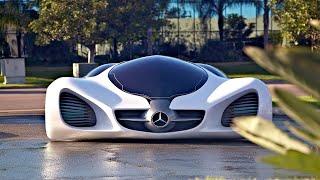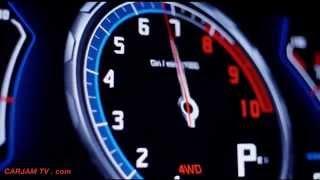Divo
Bugatti has designed and developed a hyper sports car in his honour, limiting production to just 40 units. Highly customised, high-performance and exclusive.
With the voluntary restriction of the maximum speed limit to 380 km/h, the engineers have generated additional downforce, which increases agility and lateral dynamics. The result of this work is a model that is unique in terms of technology and aesthetics. The NACA Duct air intake featuring the central fin on the roof provides the 8.0-litre W16 engine generating 1,500 PS with its intake air and improves the flow of air. It guides the air towards the 1.83-metre-wide rear spoiler in a targeted manner and minimises turbulence. Design highlights include additional air intakes, a reduced front section, a narrow front spoiler, flatter LED headlights and complex 3D rear lights. The first Divo models, which cost 5 million euros each, recently arrived with their owners. All 40 units are due to be delivered to their customers by the end of the first quarter of 2021.
Type 35
The Bugatti Type 35 is a racing car with pedigree and, like its new successor, a technical masterpiece: Bugatti used a crankshaft supported by two roller bearings and three ball bearings for the first time in the early 1920s – and this crankshaft was regarded as a feat of engineering. It could run at speeds of up to 6,000 rpm to power the eight pistons in the engine, which started out with a capacity of 2.0 litres. Two carburettors supplied the eight-cylinder engine with plenty of fuel; it achieved an output of around 95 PS, which was transmitted by a wet multi-plate clutch. The first Type 35 models drove at over 190 km/h, while later Type 35 B vehicles with the 2.3-litre eight-cylinder model achieved up to 140 PS thanks to a compressor. As a result, they could reach speeds beyond 215 km/h.
Targa Florio
In the 20th century, the Targa Florio in Sicily was considered one of the most prestigious but also one of the hardest and most dangerous endurance races in the world. The first race was held in 1906 with international racing drivers taking to the streets owned by the Sicilian business family Florio – which is where the name comes from. It did not take long until all major sports car manufacturers were taking part. Winning here meant that you had automatic proof of your speed and reliability.
Initially, one lap of the “Piccolo circuito delle Madonie” was around 148 kilometres, which was reduced to around 108 kilometres in 1919. The route ran anti-clockwise and contained around 1,400 corners. Five laps equated to 540 kilometres – on public, bumpy and dusty mountain roads. The Targa Florio remained a dangerous route in every race and you had to be truly skilled behind the wheel to conquer it. Teams were able to refuel and change tyres at any point on the track, though nominated substitute drivers could only step in at the end of a lap and in the presence of one of the race directors.
In 1925, race director and driver Meo Constantini won in a Bugatti Type 35 for the first time, repeating his victory one year later. In 1927, Emilio Materassi won in a Type 35 C, while Albert Divo won the endurance race in a Type 35 in 1928 and again one year later. Bugatti was then the first automobile manufacturer to achieved five consecutive wins in the endurance race - a feat never repeated again until the the last official race in 1977.
The former route of the “Piccolo circuito delle Madonie” passes along the historic pit lane in Floriopoli through Cerda in the west. The original circuit runs through the southern town of Caltavuturo at 500 metres above sea level and back down into the valley before tackling high mountain roads through Collesano and back down to Campofelice di Roccella. The next few kilometres run along the Mediterranean back towards Cerda.
Albert Divo: an exceptional talent
Albert Eugène Diwo, who did not change his name to Divo until later (the Italian word for “star”), is not only the eponym of Bugatti's latest creation, he was also an exceptional talent. Born in France on 24 January 1895, his interest in technology started at a young age and he started training as a ship mechanic at the age of just 13. He quickly got to grips with technically complex systems and managed to improve them.
In 1919, he joined motor racing and quickly demonstrated his talent. He started out at Sunbeam and Talbot-Darracq, winning the Spanish Grand Prix in Sitges in 1923 before switching to Delage one year later and achieving further success. In 1928, he moved to Bugatti and changed his name to Divo. In the same year, he won the Targa Florio in a Type 35, a feat that he repeated one year later. He won many races, including six Grands Prix, over a period of 20 years. He stayed with Bugatti until 1933, continuing to work as a driver and developer. Even after the Second World War, Divo remained closely linked to motorsports as a race director for an oil producer. Albert Divo died in France in 1966.
Bugatti has designed and developed a hyper sports car in his honour, limiting production to just 40 units. Highly customised, high-performance and exclusive.
With the voluntary restriction of the maximum speed limit to 380 km/h, the engineers have generated additional downforce, which increases agility and lateral dynamics. The result of this work is a model that is unique in terms of technology and aesthetics. The NACA Duct air intake featuring the central fin on the roof provides the 8.0-litre W16 engine generating 1,500 PS with its intake air and improves the flow of air. It guides the air towards the 1.83-metre-wide rear spoiler in a targeted manner and minimises turbulence. Design highlights include additional air intakes, a reduced front section, a narrow front spoiler, flatter LED headlights and complex 3D rear lights. The first Divo models, which cost 5 million euros each, recently arrived with their owners. All 40 units are due to be delivered to their customers by the end of the first quarter of 2021.
Type 35
The Bugatti Type 35 is a racing car with pedigree and, like its new successor, a technical masterpiece: Bugatti used a crankshaft supported by two roller bearings and three ball bearings for the first time in the early 1920s – and this crankshaft was regarded as a feat of engineering. It could run at speeds of up to 6,000 rpm to power the eight pistons in the engine, which started out with a capacity of 2.0 litres. Two carburettors supplied the eight-cylinder engine with plenty of fuel; it achieved an output of around 95 PS, which was transmitted by a wet multi-plate clutch. The first Type 35 models drove at over 190 km/h, while later Type 35 B vehicles with the 2.3-litre eight-cylinder model achieved up to 140 PS thanks to a compressor. As a result, they could reach speeds beyond 215 km/h.
Targa Florio
In the 20th century, the Targa Florio in Sicily was considered one of the most prestigious but also one of the hardest and most dangerous endurance races in the world. The first race was held in 1906 with international racing drivers taking to the streets owned by the Sicilian business family Florio – which is where the name comes from. It did not take long until all major sports car manufacturers were taking part. Winning here meant that you had automatic proof of your speed and reliability.
Initially, one lap of the “Piccolo circuito delle Madonie” was around 148 kilometres, which was reduced to around 108 kilometres in 1919. The route ran anti-clockwise and contained around 1,400 corners. Five laps equated to 540 kilometres – on public, bumpy and dusty mountain roads. The Targa Florio remained a dangerous route in every race and you had to be truly skilled behind the wheel to conquer it. Teams were able to refuel and change tyres at any point on the track, though nominated substitute drivers could only step in at the end of a lap and in the presence of one of the race directors.
In 1925, race director and driver Meo Constantini won in a Bugatti Type 35 for the first time, repeating his victory one year later. In 1927, Emilio Materassi won in a Type 35 C, while Albert Divo won the endurance race in a Type 35 in 1928 and again one year later. Bugatti was then the first automobile manufacturer to achieved five consecutive wins in the endurance race - a feat never repeated again until the the last official race in 1977.
The former route of the “Piccolo circuito delle Madonie” passes along the historic pit lane in Floriopoli through Cerda in the west. The original circuit runs through the southern town of Caltavuturo at 500 metres above sea level and back down into the valley before tackling high mountain roads through Collesano and back down to Campofelice di Roccella. The next few kilometres run along the Mediterranean back towards Cerda.
Albert Divo: an exceptional talent
Albert Eugène Diwo, who did not change his name to Divo until later (the Italian word for “star”), is not only the eponym of Bugatti's latest creation, he was also an exceptional talent. Born in France on 24 January 1895, his interest in technology started at a young age and he started training as a ship mechanic at the age of just 13. He quickly got to grips with technically complex systems and managed to improve them.
In 1919, he joined motor racing and quickly demonstrated his talent. He started out at Sunbeam and Talbot-Darracq, winning the Spanish Grand Prix in Sitges in 1923 before switching to Delage one year later and achieving further success. In 1928, he moved to Bugatti and changed his name to Divo. In the same year, he won the Targa Florio in a Type 35, a feat that he repeated one year later. He won many races, including six Grands Prix, over a period of 20 years. He stayed with Bugatti until 1933, continuing to work as a driver and developer. Even after the Second World War, Divo remained closely linked to motorsports as a race director for an oil producer. Albert Divo died in France in 1966.
- Category
- Autos & Vehicles






![[rFactor] Targa Florio Renault Alpine A110 1800WB´70](https://cars.showlikes.com/templates/echo/img/echo-lzld.png)






Comments